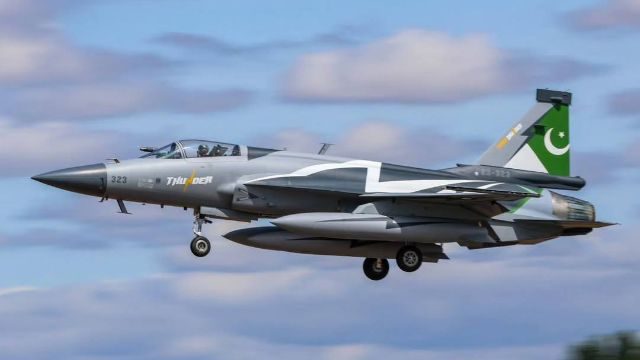The Chinese JF-17 fighter, part of the Pakistan Air Force, has arrived in the United Kingdom for the first time in a striking camouflage scheme. Photos of the aircraft landing in the UK to participate in RIAT-2025 are circulating on social media.

The Pakistan Air Force aircraft is adorned with a green tail featuring the Pakistani flag. The fuselage is painted in light and dark gray shades, with a white line resembling a thunderbolt running across the wings of the fighter. This is no coincidence, as the JF-17 is named Thunder. The word “Thunder” is inscribed on the fuselage below the cockpit, while the area housing the fighter’s radar is prominently highlighted in a dark gray shade.
This aircraft is likely a demonstration model of the Pakistan Air Force, intended for such international appearances. Traditionally, such camouflage markings are not typical for air forces. In Pakistan, these fighters are primarily painted in the standard military gray camouflage, though some emphasize green camouflage.
At previous RIAT events, the Pakistan Air Force has primarily showcased transport aircraft like the Lockheed C-130 Hercules, with participation including both static and flight demonstrations.
At RIAT-2025, however, the Pakistan Air Force’s JF-17 Block 3 is expected to be one of the highlights of the airshow, marking its first appearance at the event. According to official sources and posts on X, the JF-17 Thunder Block III will participate in both static displays and demonstration flights.
The aircraft is expected to showcase its maneuverability, speed, and combat capabilities, including performing complex maneuvers to highlight improvements in the latest Block III version, such as an active electronically scanned array [AESA] radar and enhanced avionics.
The flights will emphasize the precision and technological capabilities of the aircraft, jointly developed by Pakistan and China. Additionally, the presence of the Lockheed C-130H military transport aircraft suggests demonstrations of logistical capabilities, likely with an artistically decorated C-130, as noted in posts.
The Pakistani JF-17 Thunder, known in China as the Chengdu FC-1 Xiaolong, is one of the most notable examples of successful military-technical cooperation between Pakistan and China.
This lightweight, single-engine, multirole fourth-generation combat aircraft was jointly developed by China’s Chengdu Aircraft Corporation [CAC] and the Pakistan Aeronautical Complex [PAC] to replace outdated fighters in the Pakistan Air Force [PAF] arsenal, such as the Nanchang A-5, Chengdu F-7, and Mirage III/V.
Its design began in the late 1980s but took shape in 1999 when Pakistan and China signed an agreement for joint development. The first prototype flight took place on August 25, 2003, and the aircraft officially entered service with the Pakistan Air Force in 2007. The JF-17 was created as an affordable yet highly effective platform capable of performing a wide range of missions, including air combat, ground attack, anti-ship operations, and reconnaissance.
The aircraft is designed with a focus on versatility and modern technology while maintaining low production and maintenance costs. Its design is an evolution of the Soviet MiG-21 concept but with significant improvements in aerodynamics, avionics, and weaponry, making it entirely distinct from its predecessor. The JF-17 features a delta wing with leading-edge root extensions (LERX), enhancing maneuverability at high angles of attack and facilitating complex maneuvers.
The airframe is primarily constructed from aluminum alloys, with partial use of composite materials in newer models to reduce weight and improve performance. The aircraft has a length of approximately 14.93 meters, a wingspan of 9.46 meters, and a maximum takeoff weight of 13,500 kg.
Its high thrust-to-weight ratio, provided by the RD-93 engine [a Russian-made variant of the RD-33 used in the MiG-29], reaches 0.91 with a maximum thrust of about 81.4 kN with afterburner. This enables the JF-17 to achieve a maximum speed of approximately 1.6 Mach [around 1,900 km/h] and operate at altitudes up to 16,700 meters.
One of the key features of the JF-17 is its modular design, which allows easy integration of various systems and weaponry based on the operator’s needs. The aircraft is equipped with a digital fly-by-wire system in newer versions, improving stability and handling in extreme conditions.
The pilot’s cockpit features a modern interface, including three multifunctional color displays, a wide-angle holographic head-up display [HUD], and a Hands On Throttle And Stick [HOTAS] system, which facilitates the pilot’s execution of combat tasks. In newer models, particularly Block III, an advanced helmet-mounted display and sighting system [HMD/S] is integrated, allowing the pilot to lock onto targets with their gaze, which is particularly effective in close-range air combat.
The JF-17’s avionics are among its strongest features. In early versions [Block I and Block II], the aircraft used the Chinese KLJ-7 mechanically scanned radar, capable of tracking up to 10 targets simultaneously and engaging two. In Block III, however, an active electronically scanned array [AESA] KLJ-7A radar has been introduced, significantly improving range and accuracy, enabling tracking of up to 15 targets and simultaneous engagement of four.
The AESA radar provides better resistance to electronic jamming and is comparable to those on Western fighters of the same class. Additionally, the aircraft is equipped with an advanced electronic warfare [EW] system, an infrared missile approach warning system, and integrated communication and data exchange systems, making it suitable for network-centric operations.
The JF-17’s armament is highly versatile, reflecting its multirole nature. The aircraft has seven hardpoints [two at the wingtips, four under the wings, and one under the fuselage], capable of carrying up to 3,630 kg of payload.
Its primary gun is a twin-barrel 23-mm Type 23-2 cannon [a copy of the Soviet GSh-23L], effective for close combat and ground attack. The JF-17 can be armed with air-to-air missiles, including Chinese PL-5, PL-7, PL-10, and PL-12, as well as Western models.
RIAT [Royal International Air Tattoo] is one of the largest and most prestigious international airshows in the world, held annually at RAF Fairford in Gloucestershire, United Kingdom. Organized by the Royal Air Force [RAF] and the RAF Charitable Trust, the event brings together military and civilian aircraft from dozens of countries, showcasing the latest advancements in aviation technology through spectacular flight performances and static displays.
RIAT attracts hundreds of thousands of visitors, including aviation industry professionals and enthusiasts, and provides a platform for international cooperation, promotion of military aviation, and celebration of historical and technological achievements in the sector.
For Pakistan, the presence of this aircraft at one of the world’s most prestigious airshows is a demonstration of technological progress and military strength, as well as the successful collaboration with China in developing a modern combat platform. The JF-17, as an affordable yet highly effective multirole fighter, symbolizes Pakistan’s ambition to establish itself as a significant player in the global defense industry.
Its display at RIAT, particularly with demonstration flights, underscores the Pakistan Air Force’s confidence in the aircraft’s capabilities while serving as a platform to attract international interest from potential buyers, as the JF-17 is actively offered on the export market.
This is also a way to assert national prestige, demonstrating that Pakistan can create and operate modern military technology comparable to that of leading aviation powers.
From a geopolitical perspective, the JF-17’s participation at RIAT can be seen as a subtle signal of the strengthening strategic partnership between Pakistan and China, particularly in the context of competition with other regional and global powers.
Showcasing the aircraft on a Western stage like RIAT, where NATO nations dominate, is a way to highlight Pakistan’s independence from Western arms suppliers and demonstrate an alternative technological ecosystem based on Chinese developments.
Furthermore, the choice of Block III, with its advanced systems like the AESA radar and improved avionics, can be interpreted as an attempt to position the JF-17 as a competitor to Western fighters in the same class, such as the F-16 or Gripen.
This participation not only underscores Pakistan’s military ambitions but also serves as a diplomatic tool to build ties with other nations present at the show while sending a message of regional strength and technological independence.
***
Follow us everywhere and at any time. BulgarianMilitary.com has responsive design and you can open the page from any computer, mobile devices or web browsers. For more up-to-date news, follow our Google News, YouTube, Reddit, LinkedIn, and Twitter pages. Our standards: Manifesto & ethical principles.
How we confirmed this story:
- BulgarianMilitary.com cross-references open-source intelligence, including battlefield maps and geolocated footage, to confirm military movements and resource claims. We analyze official statements, expert insights from defense analysts, and economic data to ensure accuracy.
- Social media posts are scrutinized and validated against primary sources, such as government reports and on-the-ground accounts. Our rigorous process guarantees reliable, fact-based reporting.

